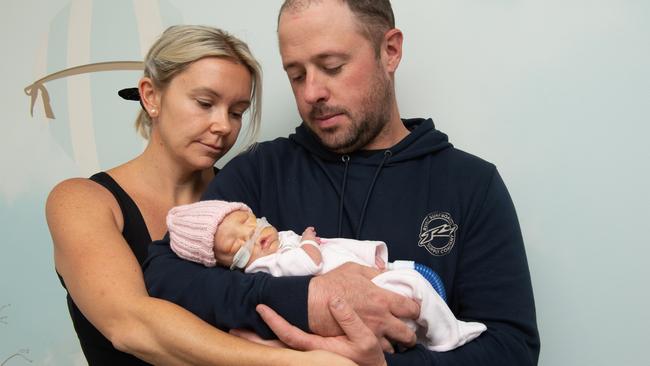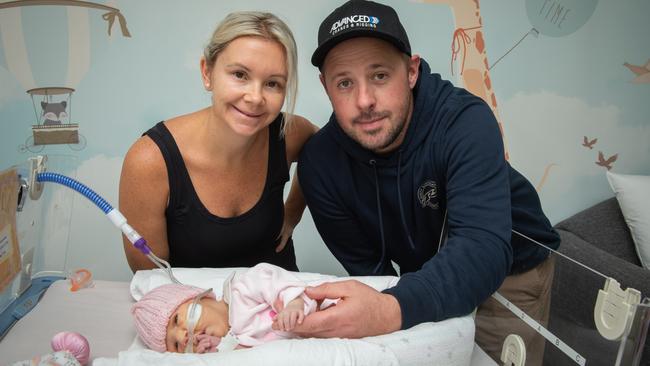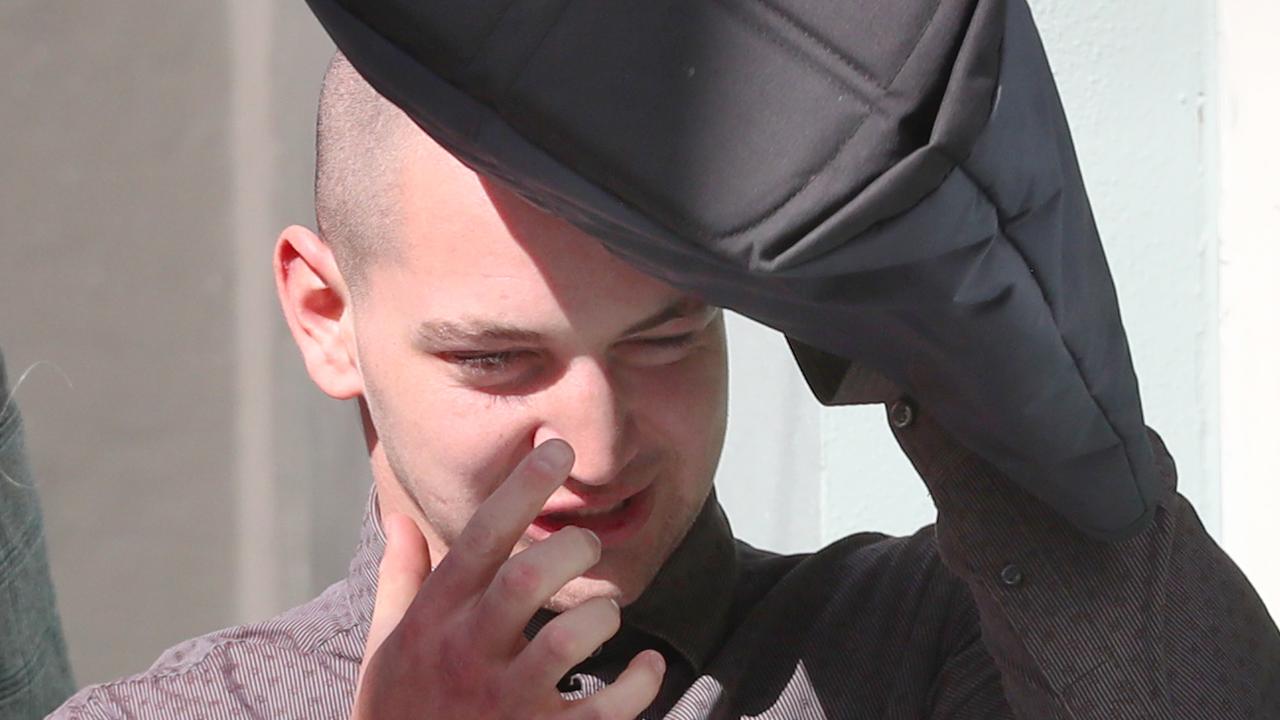Parents fight to save newborns from deadly genetic disease after losing baby girl
A Ballarat couple who lost their baby daughter at 20 days old are fighting for all newborns to be routinely screened for the deadly condition.

Victoria
Don't miss out on the headlines from Victoria. Followed categories will be added to My News.
Victorian newborns could soon be routinely screened for the most deadly genetic disease among infants, if an interstate trial is successful.
Newborn bloodspot screening — commonly known as the heel-prick test — checks babies for conditions such as cystic fibrosis and other disorders that cause severe intellectual disabilities if left untreated. But the test also has the potential to pick up fatal conditions.
In May, Ballarat parents Emma and Adam Tuddenham lost their daughter Bella at just 20 days old to spinal muscular atrophy (SMA).
They are campaigning for the Victorian government to fast-track the testing shake-up and follow NSW’s lead by including SMA screening in the heel-prick test.
They say such a move will be their late daughter’s lasting legacy.
SMA erodes motor neurons, leaving babies unable to breath or swallow. Early detection is vital to increase survival chances.

A Victorian government spokesman said: “We’re considering the implementation of spinal muscular atrophy screening, with a pilot program currently underway in NSW that will help inform whether the test is introduced in Victoria.
“Before implementing SMA screening, we’ll be doing detailed work to fully understand the impact, and ensure appropriate systems are in place for follow-up care of babies with abnormal results.”
The medical director of Victorian Clinical Genetics Services, Professor Martin Delatycki, said SMA should be screened in newborns as part of the heel-prick test because “good evidence” showed earlier intervention made treatment more effective.
Although the condition is incurable, treatment can prolong and improve a baby’s quality of life.
“It should be tested along with all of the other conditions,” Prof Delatycki said.
“The earlier someone is diagnosed, the less damage to the nervous system and the better the outcome.”

Offered free to Victorian parents who consent, the voluntary test is used around the world to screen for these conditions that do not show symptoms at birth.
Prof Delatycki said parents being screened before a pregnancy to find out if they were a carrier of SMA was just as crucial as catching the disorder early.
“People should know about the risk before they have children,” he said.
“Every woman and couple should be offered carrier screening for genetic conditions like SMA.”
Ms Tuddenham said: “It shouldn’t be dependent on what postcode you live in across Australia, we should all be offered the same test.”
“If it was offered on our heel-prick test, it would have been something that was picked up straight away instead of watching my baby fight for her life.”
The government spokesman extended their “deepest sympathies” to the Tuddenham family.
SHE FOUGHT SO HARD TO JOIN US
Three times during their pregnancy, Emma and Adam Tuddenham prayed for their unborn daughter Bella.
And three times their little girl fought for life until she was safely induced at 37 weeks.
But in the end, Bella Margy Gwen would only be with them for 20 days.
On May 18 she died in her mother’s arms, surrounded by her loving family.
She was a victim of spinal muscular atrophy (SMA), the leading genetic cause of death of Australian infants under the age of two.
It is a condition that can be diagnosed at birth with something as simple as a heel-prick test.
“My pregnancy was a six-month rollercoaster ride, the toughest time of our lives, until Bella was born,” Emma said.
“At 12 weeks we were told she may have some challenges. But every time there was a sign of a health issue, Bella would prove us wrong.
“The conclusion then was she was a much smaller baby than her 9lb (4kg) siblings.”
Bella arrived at 3:33pm on April 28 and Emma recalled their overwhelming relief when medicos announced she was perfect.

Then, 24 hours later, her fight to live started all over again.
“What we experienced was a level of hurt and pain I never even knew existed,” Emma said.
“Bella’s nervous system had begun to degenerate in-utero and for her it was too late for treatment.
“But for other babies the newborn heel-prick blood test could be the difference between life and death.”
SMA progressively destroys the motor neurons which control essential skeletal activity including breathing and swallowing — and there is no cure.
But like so many expectant parents, the couple had never even heard of SMA, and it has been a bitter pill to swallow knowing a simple blood test would detect it.
“We now see Bella’s death as a heartbreaking gift to other families — if she had passed away in-utero we would have never known it was SMA and we wouldn’t be here today fighting for change,” Emma said.
The grieving family are still recovering from the loss of a daughter and a much-awaited sister for Bailey, Chase, Nellie and Lewi.
Emma and Adam are now on a painful but what they see as a vital journey to create awareness and education around SMA.
“One in 35 people are carriers of the gene and it turns out Adam and I are both carriers, boosting chances to one in four of having a baby born with SMA,” Emma said.
A heel-prick test — to identify potentially serious conditions — is available to all Australian babies. But unlike in NSW, Victorian samples are not screened for SMA.
“If I had known I had a one-in-35 chance of being a carrier, I would have had the test. But it wasn’t even mentioned,” she said.
At birth there was no indication Bella had SMA but the next day, doctors at the Ballarat hospital flagged her lack of movement.
“She started to struggle to breathe and had minimal movement. We couldn’t hold her at all; and all we could do was touch her with our finger,” Emma said.

She was rushed to Melbourne in a special-care ambulance.
“It was tough moving her and our anxiety from that point on was just excruciating,” Emma said.
Bella underwent tests, and it wasn’t until she was five days old the family were finally able to cuddle her.
“Her lungs had improved, and she was only on airflow; her little arms had started to move and we thought she was starting to improve,” Emma said.
A muscle biopsy sent Bella’s health plummeting leaving her parents again fearful she wouldn’t make it.
But like the little fighter she was, she rallied.
It took 14 days to diagnose Bella with SMA.
“We had returned home to watch our little boy in a running event; and we received a phone call from the hospital because they had some results. I burst into tears as I knew it was bad and I just cried all night,” she said.
The diagnosis gave the couple some small comfort; because at least they knew what they were dealing with.
“Bella’s life was taken from our hands and all we could do was support her palliative care and pray for a peaceful death,” Emma said.
They are now campaigning for SMA screening to be included as part of the heel-prick test nationwide at birth, and for genetic testing for disease to be included in the 12-week prenatal screening.
“We know no amount of money will bring Bella back; but awareness, education and testing can stop this happening to other families,” Emma said.
Initially the family set out to raise $10,000 to buy a cuddle cot to allow Ballarat families to take their babies home after dying until they are laid to rest.
“Unexpectedly we raised more than $50,000 and we are now determined to reach our new goal of $100,000 before the end of the year,” she said.
August is SMA Month and the couple are hosting a 12-hour moveathon on August 28. “Change will be Bella’s legacy.
She fought her way into this life, she fought her way out and we will fight for her for change,” said Emma.




